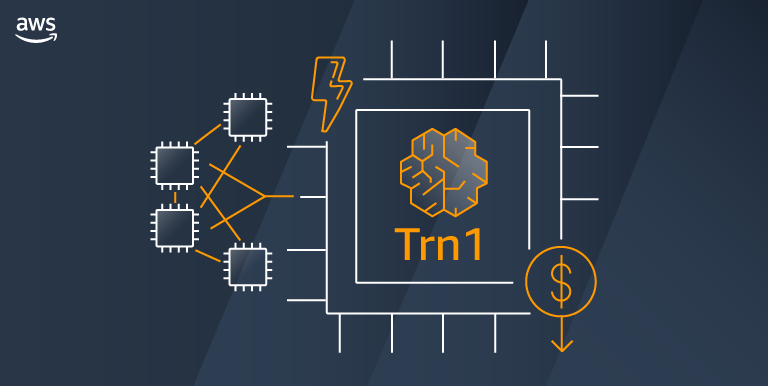PEFT fine tuning of Llama 3 (trn1.32xlarge)
This example showcases how to train Llama 3 models using AWS Trainium instances and 🤗 Optimum Neuron. 🤗 Optimum Neuron is the interface between the 🤗 Transformers library and AWS Accelerators including AWS Trainium and AWS Inferentia. It provides a set of tools enabling easy model loading, training and inference on single- and multi-Accelerator settings for different downstream tasks.
Prerequisites
Before running this training, you'll need to create a SageMaker HyperPod cluster with at least 1 trn1.32xlarge / trn1n.32xlarge instance group. Instructions can be found in the Cluster Setup section.
You will also need to complete the following prerequisites for configuring and deploying your SageMaker HyperPod cluster for fine tuning:
- Submit a service quota increase request to get access to Trainium instances in your AWS Region. You will need to request an increase for Amazon EC2 Trn1 instances, ml.trn1.32xlarge or ml.trn1n.32xlarge.
- Locally, install the AWS Command Line Interface (AWS CLI); the required minimum version needed is 2.14.3.
- Locally, Install the AWS Systems Manager Session Manager Plugin in order to SSH into your cluster.
Additionally, since Llama 3 is a gated model users have to register in Hugging Face and obtain an access token before running this example. You will also need to review and accept the license agreement on the meta-llama/Meta-llama-3-8B-Instruct model page.
Setup
In this section, we will setup our training environment on the cluster. Begin by logging into your cluster by following the SSH into Cluster section.
Step 1: Download training scripts
Begin by downloading the training scripts from the aws-awesome-distributed repo:
cd ~/
git clone https://github.com/aws-samples/awsome-distributed-training
mkdir ~/peft_ft
cd ~/peft_ft
cp -r ~/awsome-distributed-training/3.test_cases/pytorch/optimum-neuron/llama3/slurm/fine-tuning/submit_jobs .
Step 2: Setup Python Environment
Setup a virtual python environment and install your training dependencies. Make sure this repo is stored on the shared FSx volume of your cluster so all nodes have access to it.
sbatch submit_jobs/0.create_env.sh
View the logs created by the scripts in this lab by running this command below. You can update it for the step you are currently running:
tail -f logs/0.create_env.out
Before proceeding to the next step throughout this lab, check if the current job has finished by running:
squeue
Step 3: Download the model
Next, you will download the model to your FSx file volume. Begin by logging into Hugging Face using your access token mentioned in the prerequisite steps. With your access token set, you should now be able to download the model.
First modify the submit_jobs/1.download_model.sh script to include the Hugging Face access token before running it:
export HF_TOKEN="<Your Hugging Face Token>"
Then trigger the script to download the Llama3 model.
sbatch submit_jobs/1.download_model.sh
Now that your SageMaker HyperPod cluster is deployed and your environment is setup up, you can start preparing to execute your fine tuning job.
Training

In this section, you will begin training your Llama 3 model on a Trainium trn1.32xlarge instance.
Step 1: Compile the model
Before you begin training on Trainium with Neuron, you will need to pre-compile your model with the neuron_parallel_compile CLI which reduces the compilatin time during execution. This will trace through the model’s training code and apply optimizations to improve performance.
sbatch submit_jobs/2.compile_model.sh
The compilation process will generate NEFF (Neuron Executable File Format) files that will speed up your model’s fine tuning job.
Step 2: Fine Tuning
With your model compiled, you can now begin fine tuning your Llama 3 model.
For the purposes of this workshop, we will use the dolly 15k dataset. As part of the training process, the script below will download the dataset and format it in a way that the model expects. Each data point will contain an instruction that guides the model’s task, optional context that provides background information, and response that represent the desired output.
Now submit the fine tuning job:
sbatch submit_jobs/3.finetune.sh
Step 3: Model Weight Consolidation
After training has completed, you will have a new directory for your model checkpoints. This directory will contain the model checkpoint shards from each neuron device that were generated during training. Use the model consolidation script to combine the shards into a single model.safetensors file.
sbatch submit_jobs/4.model_consolidation.sh
The model.safetensors file will contain the LoRA weights of your model that were updated during training.
Step 4: Merge LoRA Weights
After consolidating the model shards, merge the LoRA adapter weights back to your base Llama 3 model:
sbatch submit_jobs/5.merge_lora_weights.sh
Your final fine tuned model weights will be saved to the final_model_path directory. You can find or update the path in the script submit_jobs/5.merge_lora_weights.sh using the argument --final_model_path.
Step 5: Validate your trained model
Now that your model is fine tuned, see how its generations differ from the base model for the dolly-15k dataset.
sbatch submit_jobs/6.inference.sh
This will generate a prediction for the question “Who are you?”, comparing the response of the base model to the fine tuned model. It will also pass a system prompt to the model to always respond like a pirate.
Before fine tuning:
{
'role': 'assistant',
'content': "Arrrr, me hearty! Me name be Captain Chat, the scurviest pirate chatbot to
ever sail the Seven Seas! Me be here to regale ye with tales o' adventure, answer yer
questions, and swab the decks o' yer doubts! So hoist the colors, me matey, and let's
set sail fer a swashbucklin' good time!"
}
After fine tuning:
{
'role': 'assistant',
'content': "Arrr, shiver me timbers! Me be Captain Chat, the scurviest pirate chatbot to ever sail the Seven Seas! Me been programmin' me brain
with the finest pirate lingo and booty-ful banter to make ye feel like ye just stumbled
upon a chest overflowin' with golden doubloons! So hoist the colors, me hearty, and
let's set sail fer a swashbucklin' good time!"
}
And that's it! You've successfully fine tuned a Llama 3 model on Amazon SageMaker HyperPod using PEFT with Neuron.